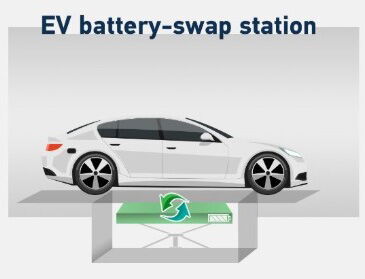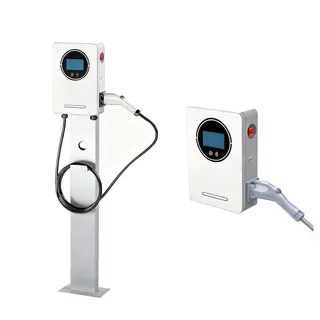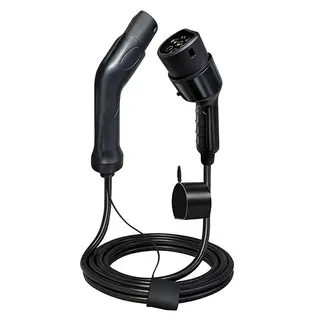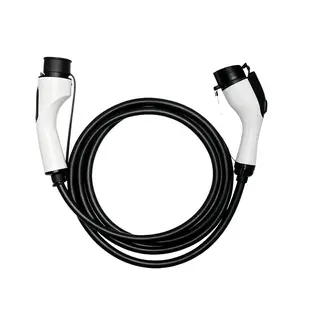In today's booming new energy vehicle (NEV) market, energy replenishment has always been a focal point for consumers. The pain points of difficult and slow charging stand like two mountains blocking the path of NEV popularization. However, with continuous technological advancements, the battery swap model and ultra-fast charging technology have emerged like two dark horses, providing new ideas and solutions for NEV energy replenishment. So, which of these two emerging energy replenishment methods is superior? Let us take a closer look.
In the exploration of NEV energy replenishment methods, the battery swap model has gradually emerged as an important option in the field of rapid replenishment. Through the unique "vehicle-battery separation" technology, it provides a new approach to energy replenishment for NEVs. Next, we will discuss in detail the definition, advantages, and challenges of the battery swap model.

The battery swap model is not a new concept. It is based on the "vehicle-battery separation" technology, allowing batteries to be centrally stored, charged, and distributed through swap stations, enabling NEVs to quickly replace batteries. In recent years, the battery swap model has gradually moved from commercial vehicles to ordinary consumers. As the number of swap stations increases, more and more consumers are beginning to accept this model.
The advantages of the battery swap model are obvious. First, it is fast. In most cases, swapping a battery takes only 3 minutes, which is far quicker compared to charging at a charging pile, which may take half an hour at the shortest or several hours at the longest. The replenishment experience for drivers can even rival refueling a gasoline vehicle. Second, vehicle-battery separation helps reduce the initial purchase cost of cars, which is another significant advantage. In the battery swap model, the car and the battery are completely independent components. Batteries account for about 40% of the initial purchase cost of an EV. In traditional integrated charging models, this significantly raises the vehicle's overall cost. With battery swap, vehicle-battery separation helps lower the initial purchase cost for consumers and also solves the mismatch between battery depreciation and vehicle body depreciation. Additionally, the battery swap model positively contributes to power grid management. The naturally distributed energy storage property of swap stations allows for effective peak shaving and valley filling, reducing grid burden and preventing centralized charging from impacting the grid.
However, the battery swap model is not perfect. Currently, it faces the following challenges:
Brand compatibility issues: Existing swap station services generally support only a single brand and cannot be shared. Solving the problem of sharing and serving more users is key to further development. At present, the battery swap model mainly applies to specific brands or models, making seamless inter-brand connectivity difficult. The large-scale development of battery swapping is constrained by the lack of unified standards, including battery pack specifications, vehicle chassis structures, and mechanical connection methods, none of which have been standardized.
High construction cost: The construction cost of swap stations is far higher than that of charging piles, and more spare batteries are needed to meet service demands. Currently, a swap station typically stores 6–8 batteries. When the number of vehicles served exceeds capacity, those waiting at the back cannot enjoy a fast swap experience. The battery swap model cannot form economies of scale in the short term, significantly limiting enterprise profitability.
Operational efficiency issues: The high efficiency of swap stations depends on sufficient battery reserves. Once the number of vehicles served is too large, operational efficiency is affected. Moreover, the construction and distribution of swap stations cannot match ultra-fast charging stations, and factors such as land availability restrict large-scale deployment.
After discussing the many features of the battery swap model, let us examine another highly focused energy replenishment method – ultra-fast charging. As an upgraded version of fast-charging technology, ultra-fast charging's core advantage lies in significantly improving charging speed, achieving a leap in charging efficiency. It can replenish a large amount of energy for electric vehicles in a short period, greatly reducing charging waiting time. Next, we will explore the definition, advantages, and practical challenges of ultra-fast charging.

Ultra-fast charging is an upgraded version of fast charging. It can charge an electric vehicle to 80% in 10 minutes or less, significantly reducing charging time and improving the utilization efficiency of charging stations. Currently, ordinary fast chargers have a power of around 120kW, conventional ultra-fast chargers around 300kW, and ultra-fast chargers from Huawei and NIO can reach up to 600kW. The charging guns of ultra-fast chargers are lightweight, making them easy to handle even for users with less physical strength, unlike the heavier chargers of the past.
The advantages of ultra-fast charging are mainly as follows:
Fast charging speed: Ultra-fast chargers provide much higher power than conventional fast chargers, allowing electric vehicles to charge up to 80% in a short time, greatly improving charging efficiency. This is especially suitable for situations requiring quick charging to continue long-distance travel.
High safety: Traditional chargers mostly use natural or air cooling, requiring ventilation openings in charging components. This allows dust to enter and adhere to electrical parts, reducing insulation, heat dissipation, charging efficiency, and equipment lifespan. Ultra-fast chargers use full liquid cooling, providing complete coverage, improving insulation and safety, and achieving a higher international electrical standard of IP65 for dust and water protection, increasing reliability.
High intelligence: Ultra-fast chargers are usually connected to smart networks, allowing remote monitoring, fault diagnosis, and maintenance, improving reliability and efficiency. They are especially suitable for service scenarios such as highway service areas, meeting customer needs for faster charging.
Although ultra-fast charging has many advantages, it also faces some challenges:
High construction cost: Ultra-fast charging stations require higher capacity and power output, as well as more powerful electricity supply and supporting equipment, resulting in high construction costs. In addition, to withstand high-voltage platforms of EVs, ultra-fast charging stations need advanced heat dissipation and pressure-bearing capabilities, increasing infrastructure and R&D costs. Therefore, it is difficult to achieve low-cost deployment.
Safety risks: Compared to ordinary chargers, ultra-fast chargers, whether using high voltage or high current, inevitably involve greater safety risks. They may shorten battery life and increase vehicle risks. Standardization of charging guns and ensuring promised maximum charging rates are unresolved challenges.
Difficulty in widespread adoption: The construction and distribution of ultra-fast chargers are limited by land, power supply, and other factors, making rapid popularization difficult. Currently, coverage is small, and brand compatibility issues limit broader adoption.
Both battery swap stations and ultra-fast chargers have advantages and disadvantages. While both can improve replenishment speed, they also involve high vehicle or charging costs. Their coverage is limited, and compatibility issues exist across brands. Therefore, in many cases, there is no need to overthink the choice between energy replenishment methods. Whether battery swapping or ultra-fast charging, some inconveniences are inevitable.
If you live in first- or second-tier cities or have nearby swap stations or ultra-fast chargers at home or work, then choosing the corresponding vehicle model is sufficient. Battery swap is more suitable for operational vehicles such as taxis and buses. Through battery swapping, drivers can maintain habits similar to gasoline vehicles while reducing costs, which is very convenient. For individual users, the need for battery swapping is not as strong. However, it is unnecessary to choose strictly between swapping and charging. Instead of simply considering which method is more reasonable, the two approaches can be combined: use regular charging for daily needs and battery swapping in emergencies. In this way, battery swapping serves as a supplement to charging, ensuring that there is a suitable energy replenishment option in any scenario.
With the continuous development of NEV technology, energy replenishment methods will become increasingly diversified in the future. On one hand, battery swap and ultra-fast charging will continue to be optimized and improved, enhancing efficiency, reducing costs, and expanding coverage. On the other hand, new energy replenishment technologies are emerging, such as wireless charging and solar charging, offering more options for NEV energy replenishment.
Regardless of the chosen method, convenience in replenishment is the most important factor. As NEV users, we look forward to a more convenient, efficient, and safe energy replenishment ecosystem, making the use of NEVs worry-free. When automakers consider the pros and cons of user operation, service, and data, they will pay more attention to actual user needs, selecting the most suitable energy replenishment method to provide a better service experience.
In conclusion, each energy replenishment method for NEVs has its own advantages and disadvantages. Battery swapping and ultra-fast charging each have their strengths. In future development, we need to consider various factors comprehensively and choose the energy replenishment method that best suits our needs, jointly promoting the high-quality development of NEVs.



